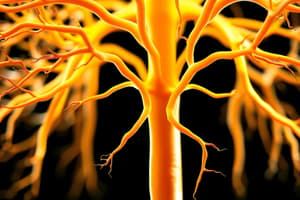Podcast
Questions and Answers
What is the function of sensory neurons?
What is the function of sensory neurons?
- Relay information to the CNS (correct)
- Carry impulses away from the CNS
- Integrate incoming sensory information
- Communicate with both sensory and motor neurons
Which type of neurons are responsible for unconscious processes like reflex actions?
Which type of neurons are responsible for unconscious processes like reflex actions?
- Photoreceptors
- Sensory Neurons
- Interneurons (correct)
- Motor Neurons
What are motor neurons also known as?
What are motor neurons also known as?
- Interneurons
- Efferent Neurons (correct)
- Mechanoreceptor Neurons
- Afferent Neurons
Which type of neurons convert physical stimuli into electrochemical signals?
Which type of neurons convert physical stimuli into electrochemical signals?
What is the function of interneurons in the nervous system?
What is the function of interneurons in the nervous system?
How are signals transmitted in the Peripheral Nervous System?
How are signals transmitted in the Peripheral Nervous System?
What is the function of the autonomic nervous system (ANS)?
What is the function of the autonomic nervous system (ANS)?
Which part of a neuron receives signals from other neurons?
Which part of a neuron receives signals from other neurons?
What is the main function of the somatic nervous system (SNS)?
What is the main function of the somatic nervous system (SNS)?
What allows neurons to generate action potentials by changing their membrane voltage?
What allows neurons to generate action potentials by changing their membrane voltage?
Which part of the nervous system includes all nerves outside the brain and spinal cord?
Which part of the nervous system includes all nerves outside the brain and spinal cord?
What is the function of the axon in a neuron?
What is the function of the axon in a neuron?
Study Notes
Overview of Neurons and the Peripheral Nervous System
The peripheral nervous system (PNS) is a part of the nervous system that includes all the nerves outside the brain and spinal cord. It consists of two major divisions: the somatic nervous system (SNS), which controls the body's skeletal muscles used for conscious movement; and the autonomic nervous system (ANS), which controls the involuntary functions such as heart rate, digestion, breathing, and glandular secretions. Both divisions work together with the central nervous system (CNS) to control various bodily functions.
Structure of a Neuron
Neurons are specialized cells that transmit information between different parts of the body using electrical signals called action potentials. They consist of three main parts: the cell body (or cyton), dendrites, and axon. Dendrites receive signals from other neurons, while the axon sends signals to other neurons or muscles. In order to send these signals, neurons require specialized adaptations. For instance, they have ion channels that allow them to generate action potentials by rapidly changing their membrane voltage. This rapid change in voltage occurs due to selective permeability of the neuronal membrane, allowing certain charged particles to move across it without moving others.
Types of Neurons and Their Functions
There are several types of neurons, each performing specific roles within the PNS. These include sensory neurons, motor neurons, and interneurons:
Sensory Neurons
Also known as afferent neurons, sensory neurons relay information from internal organs and external environments to the CNS. They convert physical stimuli into electrochemical signals for transmission to the brain. Examples of this type include taste bud neurons, olfactory receptor neurons, photoreceptors, and mechanoreceptor neurons.
Motor Neurons
These neurons also called efferent neurons, carry impulses away from the CNS to effector cells where action occurs. Effectors can be either smooth muscle cells or glands. Each motor unit comprises one motor neuron and its corresponding muscle fibers, controlling voluntary movements.
Interneurons
Interneurons communicate with both sensory and motor neurons, integrating incoming sensory information and directing appropriate motor responses. They are responsible for unconscious processes like reflex actions and posture maintenance.
Signal Transmission in the Peripheral Nervous System
Signals in the PNS are transmitted via synapses - tiny gaps between neurons. At each synapse, one neuron releases neurotransmitters, chemical messengers that travel across the junction and bind to receptors on adjacent neurons, initiating a response. This process allows complex communication networks to form between neurons, ensuring coordinated responses to various stimuli.
Studying That Suits You
Use AI to generate personalized quizzes and flashcards to suit your learning preferences.
Description
Test your knowledge about the structure of neurons, functions of different types of neurons, and signal transmission in the peripheral nervous system. Learn about sensory neurons, motor neurons, interneurons, and the role of synapses in transmitting signals between neurons.





